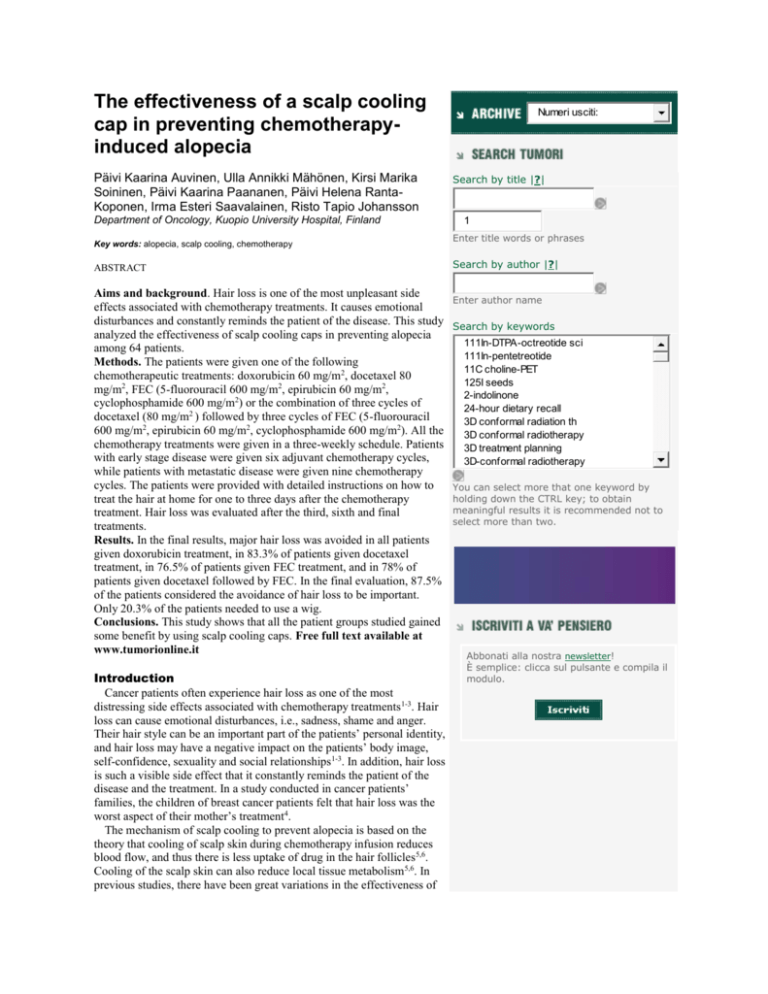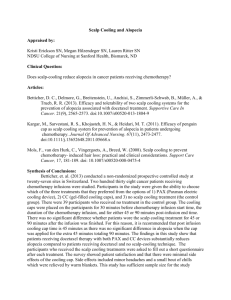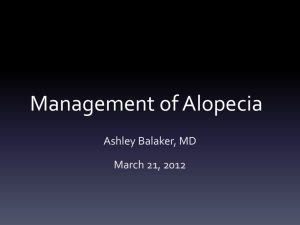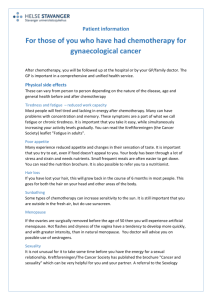Tunori Article
advertisement

The effectiveness of a scalp cooling cap in preventing chemotherapyinduced alopecia Päivi Kaarina Auvinen, Ulla Annikki Mähönen, Kirsi Marika Soininen, Päivi Kaarina Paananen, Päivi Helena RantaKoponen, Irma Esteri Saavalainen, Risto Tapio Johansson Department of Oncology, Kuopio University Hospital, Finland Key words: alopecia, scalp cooling, chemotherapy ABSTRACT Numeri usciti: Search by title |?| 1 Enter title words or phrases Search by author |?| Aims and background. Hair loss is one of the most unpleasant side Enter author name effects associated with chemotherapy treatments. It causes emotional disturbances and constantly reminds the patient of the disease. This study Search by keywords analyzed the effectiveness of scalp cooling caps in preventing alopecia 111In-DTPA-octreotide sci among 64 patients. 111In-pentetreotide Methods. The patients were given one of the following 11C choline-PET 2 chemotherapeutic treatments: doxorubicin 60 mg/m , docetaxel 80 125I seeds 2 2 2 mg/m , FEC (5-fluorouracil 600 mg/m , epirubicin 60 mg/m , 2-indolinone cyclophosphamide 600 mg/m2) or the combination of three cycles of 24-hour dietary recall 2 docetaxel (80 mg/m ) followed by three cycles of FEC (5-fluorouracil 3D conformal radiation th 2 2 2 600 mg/m , epirubicin 60 mg/m , cyclophosphamide 600 mg/m ). All the 3D conformal radiotherapy chemotherapy treatments were given in a three-weekly schedule. Patients 3D treatment planning with early stage disease were given six adjuvant chemotherapy cycles, 3D-conformal radiotherapy while patients with metastatic disease were given nine chemotherapy cycles. The patients were provided with detailed instructions on how to You can select more that one keyword by holding down the CTRL key; to obtain treat the hair at home for one to three days after the chemotherapy meaningful results it is recommended not to treatment. Hair loss was evaluated after the third, sixth and final select more than two. treatments. Results. In the final results, major hair loss was avoided in all patients given doxorubicin treatment, in 83.3% of patients given docetaxel treatment, in 76.5% of patients given FEC treatment, and in 78% of patients given docetaxel followed by FEC. In the final evaluation, 87.5% of the patients considered the avoidance of hair loss to be important. Only 20.3% of the patients needed to use a wig. Conclusions. This study shows that all the patient groups studied gained some benefit by using scalp cooling caps. Free full text available at www.tumorionline.it Introduction Cancer patients often experience hair loss as one of the most distressing side effects associated with chemotherapy treatments1-3. Hair loss can cause emotional disturbances, i.e., sadness, shame and anger. Their hair style can be an important part of the patients’ personal identity, and hair loss may have a negative impact on the patients’ body image, self-confidence, sexuality and social relationships1-3. In addition, hair loss is such a visible side effect that it constantly reminds the patient of the disease and the treatment. In a study conducted in cancer patients’ families, the children of breast cancer patients felt that hair loss was the worst aspect of their mother’s treatment4. The mechanism of scalp cooling to prevent alopecia is based on the theory that cooling of scalp skin during chemotherapy infusion reduces blood flow, and thus there is less uptake of drug in the hair follicles 5,6. Cooling of the scalp skin can also reduce local tissue metabolism5,6. In previous studies, there have been great variations in the effectiveness of Abbonati alla nostra newsletter! È semplice: clicca sul pulsante e compila il modulo. scalp cooling to prevent alopecia7. It seems there are very many factors which influence the results. There have been differences in the doses and combinations of chemotherapeutic agents. In addition, the cooling time, cooling temperature, and the condition of the hair may modify the results. The evaluation criteria and scalp cooling device may also be variable. Thus, the comparison of different studies is difficult. Nonetheless, there are studies with promising results7-11. Other reports, however, describe only minimal benefits from scalp cooling in preventing alopecia7,12-14. The inconsistency in the published data causes variation in the claims of efficacy in clinical use. This can lead to regional variations, and it may depend on the hospital if patients are offered the possibility to use scalp cooling caps or not. These type of problems may exist in many countries; for example, in the study by Mols and colleagues15 it was reported that the possibility of scalp cooling was offered in only 36% of Dutch hospitals. Randall and Ream16 found that the possibility of scalp cooling was not offered systematically to all suitable patients in an English hospital. We believe that many cancer patients would be motivated to use scalp cooling caps, but healthcare professionals need perhaps more current data to be able to give patients correct information on the effectiveness and safety of scalp cooling caps in preventing hair loss. This study evaluated the effectiveness of scalp cooling caps in preventing chemotherapy-induced alopecia among 64 patients. All the patients who participated in the study were given specific instructions on how to treat the hair at home the first 1-3 days after chemotherapy infusion. Patients and methods This prospective study includes the data of 64 consecutive patients who used scalp cooling caps during some of the following chemotherapeutic treatments: doxorubicin 60 mg/m2, docetaxel 80 mg/m2, FEC (5-fluorouracil 600 mg/m2, epirubicin 60 mg/m2, cyclophosphamide 600 mg/m2) or combination treatment with 3 cycles of docetaxel (80 mg/m2) followed by 3 cycles of FEC (5-fluorouracil 600 mg/m2, epirubicin 60 mg/m2, cyclophosphamide 600 mg/m2). All the chemotherapy treatments were given in 3-weekly schedules. Written consent was obtained from all participating patients before the first chemotherapy treatment. All patients were given written instructions and oral advice on how to treat their hair at home for 1-3 days after chemotherapy infusion (Table 1). In these instructions, the patients were advised to avoid warming and rubbing of the scalp during the first 1-3 days after chemotherapy infusion. This is based on our clinical experience that the effectiveness of scalp cooling caps to prevent hair loss depends on practical aspects such as how the patient treats the hair and the scalp at home during the first days after the chemotherapeutic treatment. Table 1 - Instructions given to patients who use scalp cooling caps during chemotherapy Wash your hair properly before the chemotherapy Have the next wash 2-3 days after the chemotherapy Avoid warm bath, swimming pool and sauna for a few days after the chemotherapy Use lukewarm water in the shower and avoid rubbing the scalp Avoid hot air when using hair dryers Use gentle hair products Avoid brushing your hair too hard Scalp cooling was achieved by gel-containing caps (Hypothermia Cap- CAP610, by Southwest Technologies, Inc, North Kansas City, MO, USA). According to the recommendations of the supplier, the cooling caps were kept in the freezer at a temperature below -25 ºC for at least 12 hours before use, placed onto the head of the patient 15-20 minutes before the start of the chemotherapy infusion, and changed every 40-45 minutes with a new cap taken from the freezer. The cooling cap was removed 15-20 minutes after the end of the infusion. Before the cooling cap was placed on the patient’s head, the hair was rinsed with cold water and the skin of the temple and forehead was protected with cotton wool. The evaluation of the hair loss was based on the international Common Toxicity Criteria (version 3.0), because these are widely used in evaluating the side effects of cancer treatments. The criteria were modified so that patients with patchy hair loss were graded to have major hair loss because visually patchy hair loss is more conspicuous than thinning of the hair. Thus the criteria used in this study were grade 0: no hair loss; grade 1: thinning of the hair; grade 2: patchy hair loss / major hair loss / complete alopecia. These criteria are presented also in Table 2. Hair loss was evaluated after the third, sixth and, in the case of longer courses, final treatment in our chemotherapy unit. The evaluation was done by the oncological nurse in cooperation with the patient. Table 2 - Criteria used for the evaluation of hair loss in the study Grade 0 1 2 Description No hair loss Thinning of the hair Patchy hair loss / major hair loss / complete alopecia The feasibility of using the scalp cooling cap was studied by asking the patients whether they felt the use of the scalp cooling cap was convenient with no side effects, tolerable with some side effects, or unpleasant with major side effects. The patients were also asked whether they considered avoidance of hair loss important or not. In this country, cancer patients are given a voucher for a wig and the wig does not cost the patient anything, and part of the patients want to have the wig at home in any case. The patients were therefore asked separately whether they had bought a wig or not, and whether they had used it or not. The results of the evaluations were written down on the study forms during the evaluation. The data were later collected and analyzed with SPSS 16.0 for Windows. Results The final analysis comprised 64 patients, all women. The mean age of the patients was 52 years (range, 32-69 years). Sixty-two (97%) patients had breast cancer, the remaining 2 (3%) were affected by sarcomas. Chemotherapy was given as adjuvant treatment to 51/64 (80%) of the patients, while the remaining 13/64 (20%) patients were treated for metastatic disease. All treatments were given in 3-weekly schedules. Doxorubicin was administered to the 2 patients with metastatic sarcomas; both received 9 cycles. Docetaxel treatment was given to 6 patients. Two of them had metastatic breast cancer and were given 9 cycles of docetaxel, while the remaining 4 patients were given 6 cycles as adjuvant treatment for early stage breast cancer. The FEC treatment group included 34 patients. Nine had metastatic breast cancer and were given 9 cycles of FEC. The remaining 25 patients in the FEC group received 6 cycles of chemotherapy as adjuvant treatment for early stage breast cancer. All the 22 patients receiving combination treatment with 3 cycles of docetaxel followed by 3 cycles of FEC were given the combination as adjuvant treatment for early stage breast cancer. All patients received the planned chemotherapy infusions. Evaluation of hair loss was done after the third, sixth, and final treatments. The numerical results are shown in Tables 3A and 3B. In all treatment groups except the docetaxel-FEC combination group, the most conspicuous hair loss was observed in the first evaluation after the third chemotherapy infusion, and there was no difference in the grade of the hair loss during the additional chemotherapy cycles. In the group receiving combination treatment of docetaxel followed by FEC, there was some additional hair loss during FEC treatments noticed in the second evaluation after the sixth chemotherapy cycle. Among the patients who received 9 cycles of chemotherapy for metastatic disease, the grade of hair loss after the final treatment was similar to that after the sixth treatment. In the final evaluation, 6 patients (9.4%) had no change in hair density. Minor changes in hair density occurred in 45 patients (70.3%), and major hair loss or total alopecia occurred in 13 patients (20.3%). With respect to the chemotherapeutic regimens, the patients who were treated with FEC, alone or after docetaxel, had more hair loss than those in the other groups. Significant hair loss or total alopecia was observed in 23.5% of patients in the FEC group and 18.2% of patients in the combination group (docetaxel × 3 followed by FEC × 3). The patients who received single docetaxel avoided mostly grade 2 hair loss. The single doxorubicin treatment was given only to 2 patients and neither of them showed significant hair loss or total alopecia (Table 3A and 3B). Table 3A - Hair loss after the third chemotherapy treatment Chemotherapy Doxorubicin Docetaxel Docetaxel Grade 0 1 (50%) 2 (33.3%) Hair loss Grade 1 1 (50%) 3 (50%) Grade 2 1 (16.7%) Total 2 (100%) 6 (100%) Table 3B - Hair loss after the sixth or the final chemotherapy treatment Chemotherapy Doxorubicin Docetaxel Docetaxel Grade 0 1 (50%) 2 (33.3%) Hair loss Grade 1 1 (50%) 3 (50%) Grade 2 1 (16.7%) Total 2 (100%) 6 (100%) Thirty-seven (57.8%) patients did not report any kind of side effect of scalp cooling. Some tolerable side effects were reported by 19 (29.7%) patients. The use of the scalp cooling cap was felt to be unpleasant by 8 (12.5%) of the evaluated patients, but they all still wanted to continue using the caps. In addition, there were 4 patients who discontinued the use of scalp cooling caps at the very onset, before the chemotherapy infusion even started, because they experienced the scalp cooling cap as unpleasant and cold. We have no clinical data on these patients because they did not want to continue in the study, so they have not been included in the results of the study. The patients’ opinions were asked in the final evaluation after the chemotherapy treatment. The majority of the patients, 56 (87.5%), considered the avoidance of alopecia important. A wig had been bought by 33 (52%) of the patients but was used only in 13 (20.3%) cases. The other patients had bought the wig for precautionary reasons. Discussion This study examined the effectiveness of the use of scalp cooling caps to prevent chemotherapy-induced hair loss. The chemotherapeutic agents selected for this study cause significant hair loss or total alopecia in most patients. This study shows that some benefit was achieved in all the studied treatment groups by using scalp cooling caps, and major hair loss was avoided in 51/64 (79.7%) of the evaluated patients. The combinations of taxane and anthracycline treatments are rather new treatment modalities. Macduff and colleagues14 reported 25% hair protection and Katsimbri and colleagues10 36% hair protection when using scalp cooling caps with a combination of taxane and anthracycline treatments. In this study, 81.8% of the patients avoided hair loss in that treatment group. In all these trials the chemotherapy infusion was given in 3-weekly cycles and the doses were comparable. However, in the study of Katsimbri et al.10 part of the patients were given paclitaxel, which has a longer infusion time than docetaxel. In addition, in the other studies anthracyclines and taxanes were given concomitantly, while in the present study the patients received taxane and anthracycline treatments sequentially. So, the mentioned differences in administration may effect the infusion time and might partly explain the differences in the results. Most of the patients who received single taxane treatment avoided major hair loss, which is in accordance with several other promising reports8,11,17. Despite new chemotherapy and antibody regimens, anthracycline-containing treatments are still needed. Although patients who received FEC experienced more hair loss than those in the other groups, major hair loss was avoided in 76.5% of the patients in the FEC group too. In the published data, there is particularly much variation in the effectiveness of scalp cooling to prevent hair loss with anthracycline treatments. In the study of Tollenaar and colleagues13 acceptable hair protection was achieved only in 11% of the patients receiving anthracycline-containing chemotherapy treatment. The chemotherapy schedule and the doses were comparable with those of the other studies, but there may have been developments in the methodological aspects because Dougherty18 reported 50%, Christodoulou and colleagues17 69%, and Peck and colleagues9 70% hair protection with anthracyclinecontaining chemotherapy infusion. In the present study, the dose of epirubicin was 60 mg/m2, and such good hair protection as achieved in this study cannot be promised to patients treated with higher doses of the drug. Anyhow, anthracycline-containing treatments are very widely used in the treatment of various types of carcinomas, and the chemotherapyinduced alopecia with anthracycline treatments may cause distress to many patients all around the world. Despite of controversial results and various chemotherapy doses, this study – together with a couple of previous studies – supports the possibility of using scalp cooling caps with anthracycline-containing treatments. When the use of scalp cooling caps was started in our unit, it was noticed that the best results were obtained in patients who avoided all warming and rubbing of the scalp in the 1-3 days after chemotherapy. By contrast, patients who visited a warm swimming pool, had a warm bath or hot sauna very soon after chemotherapy infusion were often disappointed with the results of scalp cooling in preventing hair loss. The explanation of this effect could be based on the same mechanism underlying the effectiveness of scalp cooling as such 5,6. The ability to metabolize chemotherapy agents can vary among patients, and the halflife of the chemotherapy agent and the amount of active metabolites in plasma for some time after the chemotherapy infusion can be quite substantial in some patients. Thus, manipulation and warming of the scalp skin 12-48 hours after the end of the infusion might increase the blood flow and elevate the metabolic activity in the hair follicles. In order to achieve good results, scalp cooling is done best according to the methods that have been tested in clinical trials. In addition, the use of scalp cooling with the chemotherapy agents with a short infusion time, and informing the patient how to treat the hair and the skin of scalp at home after chemotherapy treatment are also important. The most common side effects of scalp coolers are headache, a cold sensation in the skin of the scalp, and shivering7. Previous studies have found that a small proportion of patients had to discontinue the use of scalp coolers10,11,14. In addition to the 64 evaluated patients, there were 4 patients in this study who did not tolerate the use of scalp cooling and they could use the scalp cooling cap for only a couple of minutes. Two of them complained of headaches and the other 2 experienced scalp cooling as too unpleasant. One in every 8 of the evaluated patients stated that using the scalp cooling caps was unpleasant, but still wanted to continue using the caps. These results are in accordance with the reported data 7,9,15 . We recommend taking patients’ feelings and experiences seriously. For the small proportion of patients who do feel the use of scalp cooling cap to be unpleasant, the decision to discontinue may not be easy because they may have had great expectations. They therefore need support in this situation. However, most of the patients can tolerate scalp cooling well, and 79.7% of the patients in this study did not need to resort to wearing a wig. Many of them were satisfied with the result achieved with scalp cooling. They reported during the evaluations that they considered the possibility to avoid hair loss important for their sexual attractiveness and for the relationship with their husbands. The avoidance of hair loss was especially important for middle-aged women who felt that their hair was the most beautiful part of their bodies. For the healthcare professionals and the patients themselves, the most important factor is the effectiveness of the chemotherapy treatment; both groups want to know whether the use of scalp cooling caps is safe. The recent study by Lemieux et al.19 reported that the incidence of scalp metastases did not increase among breast cancer patients who had used scalp cooling during neoadjuvant and adjuvant chemotherapy treatments. In patients with advanced breast cancer, there are reports of occasional scalp metastases. But, according to the literature, there is no evidence that the incidence of scalp metastases increased among patients who had used scalp cooling, and the appearance of scalp metastases has been only associated with the spread of the disease7,8,10,20. During the last 2 decades, in our institute we have encountered a couple of breast cancer patients with scalp metastases, but neither of those patients had used scalp cooling caps. Although alopecia is not life-threatening, it comes at a critical time for patients, because they have to face the cancer diagnosis or the possibility of progression of malignancy. Alopecia, together with the malignant disease, may have a negative impact on the patient’s body image, selfconfidence, and social relationships1-3. Cancer patients have rated alopecia as an unpleasant side effect1-3, and 87.5% of the patients in this study considered avoidance of alopecia as an important end point. The use of scalp cooling caps is a moderately effective method to prevent hair loss during certain chemotherapy regimens. We encourage healthcare professionals to have scalp cooling systems available and to discuss the possibility of using them with cancer patients whenever it is safe and possible. References 1. Batchelor D: Hair and cancer chemotherapy: consequences and nursing care – a literature study. Eur J Cancer Care, 10: 147-163, 2001. 2. Carelle N, Piotto E, Bellanger A, Germanaud J, Thuillier A, Khayat D: Changing patient perceptions of the side effects of cancer chemotherapy. Cancer, 95: 155- 163, 2002. 3. Hunt N, McHale S: The psychological impact of alopecia. BMJ, 331: 951-953, 2005. 4. Forrest G, Plumb C, Ziebland S, Stein A: Breast cancer in the family - children’s perceptions of their mother’s cancer and its initial treatment: qualitative study. BMJ, 332: 998-1001, 2006. 5. Gregory R, Cooke T, Middleton J, Buchanan RB, Williams CJ: Prevention of doxorubicin-induced alopecia by scalp hypothermia: relation to the degree of cooling. BMJ, 284: 1674, 1982. 6. Janssen F, Bouten C, van Leeuwen G, van Steenhoven A: Effects of temperature and doxorubicin exposure on keratinocyte damage in vitro. In Vitro Cell Dev Biol Anim, 44: 81-86, 2008. 7. Grevelman E, Breed W: Prevention of chemotherapy-induced hair loss by scalp cooling. Ann Oncol, 16: 352-358, 2005. 8. Lemenager M, Lecomte S, Bonneterre ME, Bessa E, Dauba J, Bonneterre J: Effectiveness of cold cap in the prevention of docetaxel-induced alopecia. Eur J Cancer, 33: 297-300, 1997. 9. Peck HJ, Mitchell H, Steward AL: Evaluating the efficacy of scalp cooling using the Penguin cold cap system to reduce alopecia in patients undergoing chemotherapy for breast cancer. Eur J Oncol Nurs, 4: 246-248, 2000. 10. Katsimbri P, Bamias A, Pavlidis N: Prevention of chemotherapy-induced alopecia using an effective scalp cooling system. Eur J Cancer, 36: 766-771, 2000. 11. Ridderheim M, Bjurberg M, Gustavsson A: Scalp hypothermia to prevent chemotherapy-induced alopecia is effective and safe: a pilot study of a new digitized scalp-cooling system used in 74 patients. Support Care Cancer, 11: 371377, 2003. 12. Giaccone G, Di Giulio F, Morandini M, Calciati A: Scalp hypothermia in the prevention of doxorubicin-induced hair loss. Cancer Nurs, 11: 170-173, 1988. 13. Tollenaar R, Liefers G, van Driel R, van de Velde C: Scalp cooling has no place in the prevention of alopecia in adjuvant chemotherapy for breast cancer. Eur J Cancer, 30: 1448-1453, 1994. 14. Macduff C, Mackenzie T, Hutcheon A, Melville L, Archibald H: The effectiveness of scalp cooling in preventing alopecia for patients receiving epirubicin and docetaxel. Eur J Cancer Care, 12: 154-161, 2003. 15. Mols F, van den Hurk C, Vingerhoets A, Breed W: Scalp cooling to prevent chemotherapy-induced hair loss: practical and clinical considerations. Support Care Cancer, 17: 181-189, 2009. 16. Randall J, Ream E: Hair loss with chemotherapy: at a loss over its management? Eur J Cancer Care, 14: 223-231, 2005. 17. Christodoulou C, Klouvas G, Efstathiou E, Zervakis D, Papazachariou E, Plyta M, Skarlos DV: Effectiveness of the MSC cold cap system in the prevention of chemotherapy-induced alopecia. Oncology, 62: 97-102, 2002. 18. Dougherty L: Scalp cooling to prevent hair loss in chemotherapy. Prof Nurse, 11: 507-509, 1996. 19. Lemieux J, Amireault C, Provencher L, Maunsell E: Incidence of scalp metastases in breast cancer: a retrospective cohort study in women who were offered scalp cooling. Breast Cancer Res Treat, 118: 547-552, 2009. 20. Christodoulou C, Tsakalos G, Galani E, Skarlos DV: Scalp metastases and scalp cooling for chemotherapy-induced alopecia prevention. Ann Oncol, 17: 350, 2006.








